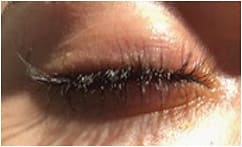A 26-year-old, one-year-postpartum patient reported very dry eyes, especially since the birth of her child. She also noted that the dryness fractured her sleep and was worse in the morning upon awakening. She slept with a pillow over her eyes in an effort to ameliorate her symptoms. I asked whether she was ever told that her eyes were open when she was asleep. Her reply: “Yes! Since I was a child. Everyone in my family has the same problem because our eyelashes are so long, they push our eyes open at night.” Indeed, she had extremely long, thick, healthy-looking eyelashes in multiple rows on the upper and lower eyelids. The lashes were the longest and thickest temporally in each eye. And, when she closed her eyes, the abutting curves of the upper and lower eyelashes interfered with the lids making contact without forced closure by the patient (Figure 1). Additionally, there was some laxity of the lids, so there was a sliver of lid eversion when the eyes closed (akin to floppy eyelid syndrome).

Trichomegaly
Hypertrichosis is an increase in hair, taking a patient’s age, gender, and ethnicity into consideration. Eyelash hypertrichosis, a term first used by H. Gray in 1944, is known as trichomegaly. Eyelash trichomegaly is increased length, curling, pigmentation, or thickness of eyelashes. Trichomegaly can manifest at birth as part of the spectrum of manifestations of some congenital syndromes, can be acquired later in life, or can occur with certain drug use (Paul et al, 2012). Trichomegaly can result in mechanical ptosis or corneal abrasions and visual disturbances if trichiasis occurs.
Trichomegaly can be familial without any other eye/system abnormality (Kaur and Mahajan, 2015). Congenital associations (and their presentations) include Oliver-Macfarlane syndrome (retinitis pigmentosa and mental and growth retardation); Cornelia de Lange syndrome (synophrys, low hairline, and developmental and musculoskeletal abnormalities); cone-rod dystrophy (congenital hypertrichosis); congenital heart disease (Tetralogy of Fallot); Hermansky-Pudlak syndrome (tyrosinase-positive oculocutaneous albinism and systemic complications of lysosomal dysfunction); Goldstein-Hutt syndrome (cataracts and hereditary spherocytosis); phylloid hypomelanosis (hypopigmented leaf-like macules, cerebral as well as ocular and skeletal abnormalities); and Kabuki syndrome (facial features include arched eyebrows, long palpebral fissures with ectropion of the lateral third of the lower eyelids, flat, broadened tip of the nose, and large protruding earlobes) (Patel and Joos, 2021).
Other causal acquired conditions may include hair disorders such as alopecia areata; connective tissue disorders such as dermatomyositis and systemic lupus erythematosus; allergic rhinitis, atopic dermatitis, and vernal keratoconjunctivitis; human immunodeficiency virus (HIV) infections; malignant conditions such as metastatic renal adeno-carcinoma; uveitis; and miscellaneous conditions including anorexia nervosa, malnutrition, hypothyroidism, porphyrias, and pregnancy.
Additionally, drugs that can cause trichomegaly include prostaglandin analogs used to treat glaucoma (e.g., latanoprost, bimatoprost), epithelial growth factor receptor tyrosine kinase inhibitors, cyclosporine, topiramate, tacrolimus, and interferon-alpha.
The Price of Beauty?
The patient appears to have familial trichomegaly without any other abnormality. However, the next time I see this obvious, unusual clinical sign, I will think back to the list of not-so-lovely-to-have related disorders/precipitators for it. CLS
For references, please visit www.clspectrum.com/references and click on document #310.




